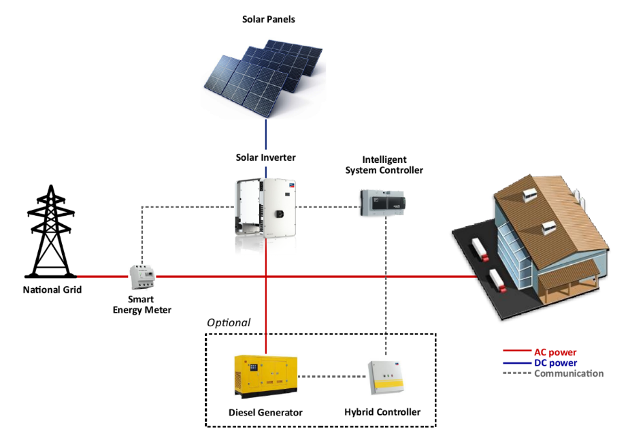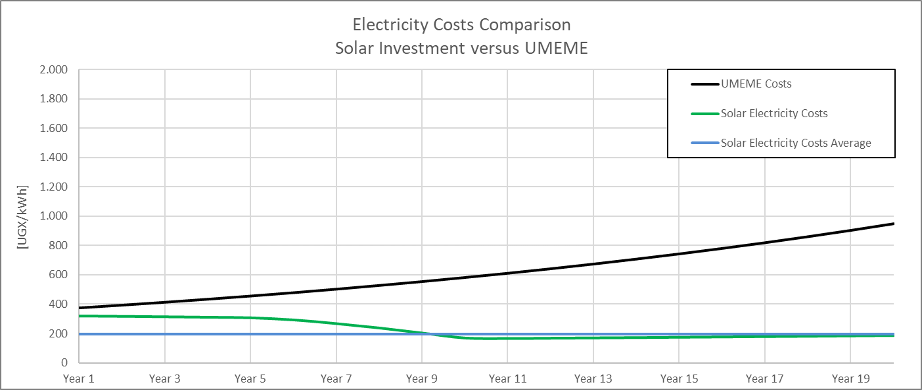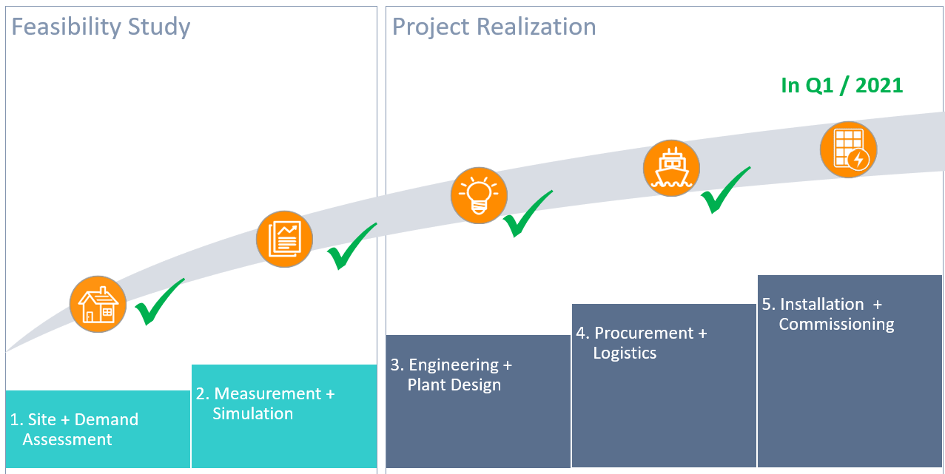Knowledge fuels change
For over a decade, Energypedia has shared free, reliable energy expertise with the world.
We’re now facing a serious funding gap.
Help keep this platform alive — your donation, big or small, truly matters!
Thank you for your support
Solar Energy Plant for Self-Consumption in Uganda
Self-Consumption Solar Plant at a Dairy Farm in Uganda
This case study portrays the first self-consumption solar plant at a dairy farm in Uganda, which is a new and innovative solar energy concept in the country. As a result, many manufacturers and industries can now produce their own inexpensive energy with captive power plants.
The advantages of this concept can be outlined as follows:
- Increasingly Popular: Captive power plants are becoming increasingly popular among industrial complexes who require constant energy to power their operations. Captive power plants can be in schools, hotels, offices & industrial companies.
- Produce and Consume Your Own Energy: Energy production and consumption occur together at the source. Hundred percent of the power generated is utilised by the owner/producer of the plant.
- Grid connected: Although the location where a captive power plant is deployed may be grid-connected, the electricity generated is not sent to the national grid.
- Save Money: An own energy plant will always be cheaper than a grid energy supplier.
- Finance Schemes Available: A captive plant can be fully financed by the user of the electricity, the developers of the project or a third party financier.
Solution Concept by Equator Solar
Most facilities do have sufficient space on the roof or ground for such a plant. Our solution will be designed as a third energy source beneath the national grid and your back up Diesel Generator. But it will be your smartest and cheapest source of energy in your plant energy supply.
Main Components
The Solar Plant on Your Roof (or Ground)
Equator Solar uses system technology from the world leading inverter manufacturer SMA Solar Technology AG, Germany for its industrial solar systems. The advanced system technology allows smart designs and automatic integration of other power sources like the national grid or diesel generators. The solar system always operates together with another power source like the national grid or a diesel generator which prevents from running into power shortages and ensures that appliances of unlimited capacity can be operated. The solar panels generate clean electricity which is directly supplied to the consumers without the need for battery storage. Depending on the number of solar panels installed and load characteristics up to 50 % of the total electricity demand can be covered by solar.

Connection to The Grid
A grid synchronized solar system requires the availability of another grid-forming electricity source for operations. A standard captive power solar system cannot generate electricity during power cuts. This requires the additional application of fuel saving technology to also reduce diesel consumption. In addition, the generation of a solar PV system in captive power configuration can never exceed the current power consumption because all power generated has to be consumed directly. Therefore, it can be required to reduce the solar generation on times with low demand to meet the actual power consumption.
The actual solar generation is influenced by various factors like number of UMEME power cuts, fluctuations in electricity consumption, metrological conditions (actual solar radiation, amount of rain, temperature), environmental factors (dust, smog, soiling of panels) and operating conditions (frequency of solar panel cleaning, maintenance).
An Intelligent System Controller Manages the Energy Sources
Our system controller will automatically give priority to the best available source of energy for your consumers. It monitors the energy demand and manages the energy sources.
Save Fuel by Integrating your Diesel Generator
The flexible system technology optionally allows diesel generator integration into the solar system. This enables the solar system to work hand in hand with the diesel generator and to reduce diesel consumption during UMEME outages and to also increase savings. The integration of the diesel generators into the solar system by applying fuel saving technology can also be done in a further project phase and is not part of this offer.
Your Benefits
- Save money from day one - growing savings
- Investment with very good returns
- Long-term value - 25+ years lifetime
- Improve carbon footprint - Go Green!
Business Case and Financing
Based on your individual data and situation, we develop a business case with you, and give you a first idea of your investment and savings potential.
This graph shows the low average solar energy costs in comparison to UMEME over 20 years:

The Current Reference Project
At the moment, the name of the reference project can not disclosed. The project has been contracted some months ago. Before contracting with the client, Equator Solar applied for the grant at the Deutsche Energie Agentur (dena – German Energy Agency). With this fund, the project costs could be reduced for the benefit of the client before signature.
Today, the project is awaiting the finalisation of the construction of a new production site, which is expected to be done by end of the year. All materials and equipments have already been procured, shipped, imported and delivered to the new production site. In the beginning of year 2021, we will then do the construction works and commission the plant accordingly.

Due to the pandemic situation the project is currently delayed by some months, mainly due to logistics reasons. Under regular conditions, such a project would have a duration from first site assessment until commissioning of nine months, depending of course on the speed of the decision making.
What counts: fast decision means fast beginning of savings!
Supporters
This project is supported by:
Deutsche Energy Agentur (dena – German Energy Agency)
dena is the centre of expertise for energy efficiency, renewable energy sources and intelligent energy systems. As Agency for Applied Energy Transition we help achieve energy and climate policy objectives by developing solutions and putting them into practice, both nationally and internationally. In order to do this, we bring partners from politics and business together, across sectors. dena’s shareholders are the Federal Republic of Germany and the KfW Group.
German Energy Solutions Initiative
The transfer of energy expertise, the promotion of foreign trade and the facilitation of international development cooperation are part of the German Energy Solutions Initiative, which is coordinated and financed by the German Federal Ministry for Economic Affairs and Energy. The initiative offers networking and business opportunities in Germany and abroad, it showcases reference projects and facilitates know-how exchange.
dena Renewable Energy Solutions Programme (dena RES Programme)
The dena RES Programme was developed by the Deutsche Energie-Agentur (dena) – the German Energy Agency. This programme, supported by the Federal Ministry for Economic Affairs and Energy within the German Energy Solutions Initiative, helps German renewable energy companies enter new markets. Within the framework of the programme, reference and demonstration projects are installed in cooperation with prestigious institutions. The installation is accompanied by comprehensive PR, marketing and training programmes. These projects showcase high-quality German renewable energy technology and help participating companies gain a foothold in new markets.
The project described above has been granted by the Deutsche Energy Agentur (dena) for the following reasons:
- It introduces an innovative technology to Uganda
- It demonstrates the state of the art and high quality approach of German Engineering
- It will be a reference for other potential customers in the country
- It supports the capacity building of local resources in terms of knowledge and expertise



















